Potential energy to kinetic energy conversion is a never-ending cycle as it is an essential part of our daily lives. This article discusses the list of potential energy to kinetic energy example as listed below:
Book on Table
The book lying on the table is at rest; hence it has stored or potential energy. But when you pick up the book from the table, its potential energy becomes kinetic energy as its position changes, and it is in motion along with you.
However, as soon as you place the book again on the table, its kinetic energy is converted back into its potential energy as the book is now again at rest with respect to the table.
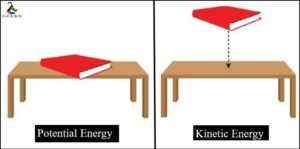
– Book on Table
Read more about the relative motion between two interacting objects.
Car at the Hilltop
First, to reach the hilltop, the car’s engine must do enough work to uplift the car by turning its kinetic energy into potential energy. Therefore, at the top of a hill, the car has zero kinetic energy with maximum potential energy equal to the work done.
Now, even if the engine turns off, the car will still coast down the hill from the top. The maximum potential energy is then converted into kinetic energy as the car changes its stationary position from top to bottom of the hill.
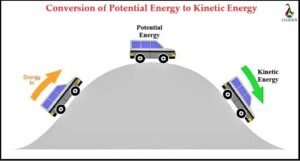
– Car at the Hilltop
Read more about the work done and its correlation with energy.
Falling Objects
Any objects such as a ball, stone, or apple at a certain height have the potential energy due to their lifted position.
When we released an object from height, it naturally pulled down toward the ground by the force of gravity. An object will fall towards the ground as its potential energy transforms into its kinetic energy. It will have rested on the ground finally when its potential energy is exhausted.
In the energy conversion, the exact amount of potential energy is converted into kinetic energy. Therefore, it is crucial to consider that the energy cannot be created; nor destroyed – as per the law of conservation of energy.
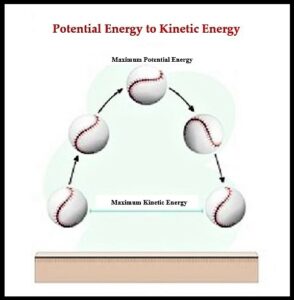
– Falling Objects (credit- shutterstock)
Read more about the types of forces exists around us.
Skydiver
When skydivers are standing on the airplane to jump from a height, they stored potential energy at such altitude.
When they finally jump from the plane, their potential energy to kinetic energy conversion occurs, accelerating their motion downwards towards the ground.

– Skydiver (credit: shutterstock)
Hammering a Nail
The activity of hitting a nail into the wall by hammer gives us three things we should note:
- Since the hammer has the potential to move higher or lower, the raised hammer before hitting a nail has maximum potential energy.
- When you hit a nail with the hammer, the maximum potential energy to kinetic energy conversion occurs as we lowered the hammer from height.
- Finally, as soon as the hammer hits a nail, secondary energy conversion occurs, and the hammer gains potential energy again at rest.
The hammer’s example shows that energy is not lost during the whole energy conversion process; it just changes its form from one to another – as per the law of conservation of energy.
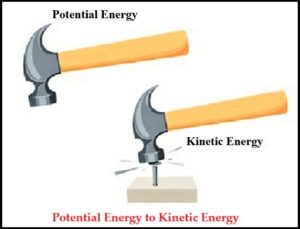
– Hammering a Nail (credit: shutterstock)
Dam Water
The lake or water level in the upper section of the dam has the potential energy since the water from the flowing river is stored at a certain height.
But when the dam’s doors open, its stored potential energy is converted into kinetic energy as upper section water starts to flows to the lower levels.
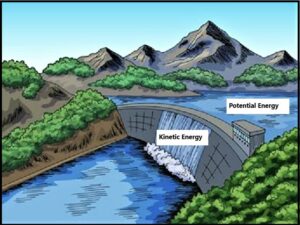
– Dam Water (credit: shutterstock)
Roller Coaster
While designing any roller coaster, the engineers secure that there would be adequate potential energy to overcome the energy-draining effect of friction – to move its car through the entire ride.
That means, at the start of the ride, the cars must have enough stored energy – which powers them to run throughout the ride. This motion can be achieved by raising the roller coaster car to a certain height. That is the main reason why the roller coaster usually begins with a big hill.
When the car finally starts running down the hill, its stored potential energy transforms into kinetic energy, which speeds up the car; and keeps it in motion for the particular length of the track.

– Roller Coaster (credit: shutterstock)
Read more about the inclined plane that makes work easier.
Stretched Rubber Band
We do work on the elastic rubber band by applying muscular force to stretches it out. Even though we are holding the stretched rubber at rest, it has the potential to move and gain its original shape when we release it. That is the potential energy.
When we finally release the rubber band, its potential energy is transformed into kinetic energy to snaps back to its original shape.

– Stretching Rubber Band (credit: shutterstock)
Simple Pendulum
When we apply a force on the suspended object of the pendulum by pulling or pushing to a higher position, it gains maximum potential energy. In reaction to our applied force, the restoring force is exerted on the pendulum’s string, which helps its object return to its lower position. The required restoring force is stored in the pendulum’s suspended object.
Therefore, when we release an object from a certain height, its potential energy is converted into kinetic energy due to restoring force by the pendulum’s string.

– Simple Pendulum (credit: shutterstock)
Compressed Spring
Considering the spring, like elastic rubber, we can physically pull or push it to convert its elastic potential energy into kinetic energy. The more force we apply to it, the more its potential energy is stored, and the more conversion to kinetic energy happens when we let it go.
When the compressed spring is released, the spring’s stored energy will resume its original length, causing a motion to an object.
As the spring starts to elongate, a small portion of its potential energy is converted to thermal energy as there might be friction between an object and the surface of the spring. That means compressed spring’s potential energy can have converted into other forms of kinetic energy. Here, we note that other unintended energy conversions also occur when the energy is converted from one form to another.
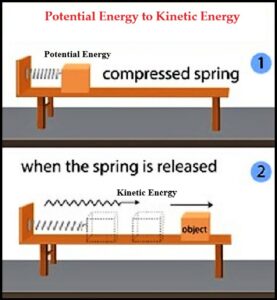
– Compressed Spring (credit: shutterstock)
Read more about the sliding friction examples.
Battery
Consider the electrochemical battery is attached to the light bulb to illuminate it. The turn-off battery contains stored chemical potential energy.
When we turn on the battery, the movement of internal particles causes the conversion of chemical energy into electrical kinetic energy – to transport the electricity to the bulb —That’s how the battery’s working principle also converts various forms of energy.

– Battery (credit: shutterstock)
Flashlight
Like the battery, when we turn the flashlight, its chemical potential energy is converted into another form of kinetic energy known as light energy. Note that here the flashlight not only lights up but also gets heat up. That means the generation of heat energy occurs along with light energy from its chemical potential energy.
This heat energy generation we usually consider as the energy which is lost during the primary energy conversion. That means an unintended conversion like lost energy occurs during the primary conservation.

– Flashlight (credit: shutterstock)
Exothermic Chemical Reaction
The potential energy of particles is the leading cause of the exothermic chemical reaction. When the internal particles such as electrons and protons transition from having higher potential energy to lower potential energy, the conversion of their potential energy into heat energy occurs. The energy conversion leads to breaking existing chemical bonds and forming new bonds in the exothermic reaction.
In an endothermic reaction, the opposite process occurs. The protons and electrons gain maximum kinetic energy as they start moving.

– Exothermic Vs Endothermic Reaction (credit: shutterstock)
Burning of Oil, Gas and Coal
When we talk about gas, coal, or oil, we are talking about “stored†energy.
Let’s take three cases – a barrel filled with oil or a gallon filled with gas or a box containing a coil.
When we burn oil, gas, or coal, their stored energy is released as it involves exothermic reactions. Then their stored potential energy transformed into different forms of kinetic energy.

– Burning oil (credit: shutterstock)
Wind Turbine
Renewable sources like wind energy are one of the forms of potential energy. When wind energy falls on one of the blades of the wind turbine, it starts spinning.
Since the turbine contains the generator that converts the wind energy into electricity – one form of kinetic energy, the concept of energy conversion from potential to kinetic energy plays a vital role in making our earth greener.

– Wind Turbine (credit: shutterstock)
How is Potential Energy converted to Kinetic Energy?
Potential energy converted into kinetic energy either by human activity or naturally as follows:
The energy conversions of an object depend on its position. When the object is at rest or stationary, it stores the potential energy. When any force is applied to a stationary object, it accelerates an object in the direction of the applied force. As an object’s position changes, its stored potential energy is converted into the energy of motion called kinetic energy, speeding an object more. This energy conversion from potential to kinetic continues in both directions simultaneously, often in various forms of kinetic and potential energy all at once.
Also Read:
- Example of electrical energy to chemical energy
- Example of gravitational energy to mechanical energy
- Example of kinetic to electrical energy
- Example of mechanical to kinetic energy
- Mechanical energy to kinetic energy
- Can elastic potential energy be negative
- Example of chemical energy to kinetic energy
- Is kinetic energy conserved in impulse
- Example of kinetic to thermal energy
- Gravitational energy to mechanical energy

Hello, I’m Manish Naik completed my MSc Physics with Solid-State Electronics as a specialization. I have three years of experience in Article Writing on Physics subject. Writing, which aimed to provide accurate information to all readers, from beginners and experts.
In my leisure time, I love to spend my time in nature or visiting historical places.
Looking forward to connecting you through LinkedIn –